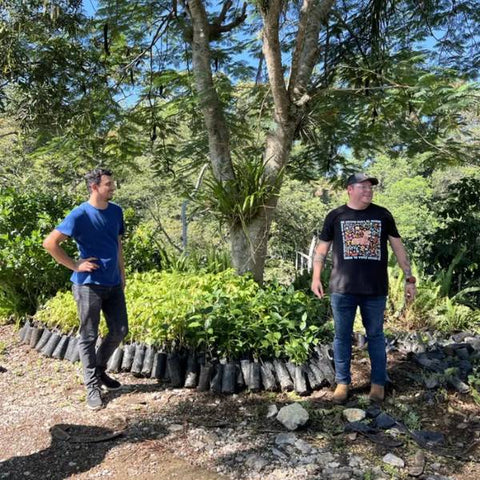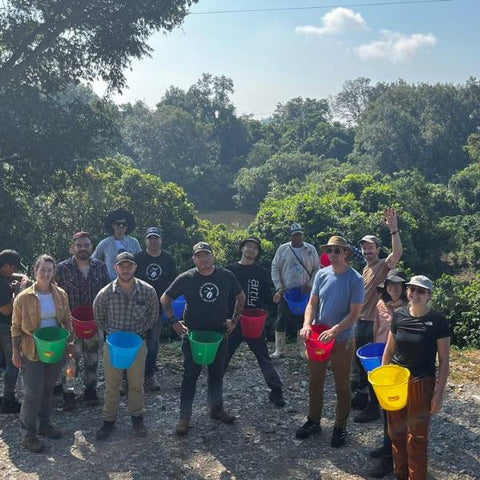A farm-to-cup experience in one of our favorite coffee growing regions
In late September, Stephanie and Bryce, owners of Pinup Coffee Co, headed down to Mexico to visit coffee farms, experience coffee production, and of course taste some great coffee alongside the 2023 coffee industry champions. Read on for details about the experience and our honest take on what we learned.
We were invited on the trip by one of our importing partners in tandem with NKG Bloom - whose mission is to ensure the long-term viability of green coffee supplies by providing smallholder farmers with the opportunities and resources they need to run their farms at full potential and enter a pathway out of poverty. We were able to see their mission in action, meet coffee farmers (one family of which we purchased coffee from in 2022), and experience Mexican coffee culture.
As a coffee roaster, we know that the quality of any particular roasted coffee is dependent upon the growing region, farming processes, processing methods, transportation and more. Many hard-working hands and minds are required to get great coffee into our cups each morning, and it’s hard to understand the gravity of that statement until you see it in person. We left with an even deeper appreciation for the farmers that provide us with our energizing morning coffee.
Exportadora de Café California Veracruz, Mexico

On day one we met up with the group at ECC (Exportadora de Café California) in Veracruz for a tour of their massive facility and a cupping of some of ECC’s finest coffees of the year.
Coffee arrives here in its parchment (yellow tough skin-type layer over the coffee seed), organized by lot number and ready for hulling. We explored massive warehouses where the coffee is taken in, separated by farm or lot (for specialty coffees, not necessarily all coffee that comes here gets this extra care), hulled, sorted and prepared for export. Naturally, we explored every inch and dug into some deeper questions like the workers pay, benefits and traceability of coffee. We were happy to learn that workers here get paid well and receive benefits like medical and meals, a standard above most in Mexico.
After walking the warehouses and processing plants, we were able to visit the “art studio” where our coffee trader guide showed us some of his designs painted on coffee bags, some of which we have at our roastery! We made our way from there through the state-of-the-art sample roasting center, and into the coffee lab. We finished the day with a cupping of some exceptional Mexican coffee offerings before heading to Cordoba for the night.
Finca El Rio, the Domingues Perez family, Zongolica

A three-hour ride in the back of a pickup truck through the jungle led us to the Finca El Rio farm high in the mountains. Winding roads through villages with small homes spread throughout the near-vertical terrain made it clear that growing coffee at this high altitude is not for the faint of heart.
The farm is a small family-run plantation that has been in the family for decades. They grow Arabica and Robusta coffee. Despite their recent success the farm was in serious need of help not long ago. It was here that we gained a deeper appreciation for groups like NKG - who sent agronomists to help turn around this family farm with their work, training, and even young trees. They helped turn this plantation into a farm that produced significantly more coffee with even higher quality. This means a more secure future for the family, who also grows oranges and vanilla beans to supplement their income.
Agronomists from NKG walked us around the ever steep, shady mountain and gave detailed explanations of the key steps involved in growing coffee, such as soil preparation, planting, and pruning. This farm has an abundance of shade, which is important for healthy arabica trees, and is an astonishing view of the biodiversity of Zongolica.

Drying patio at Finca El Rio
Visiting Finca El Rio is an honest reminder that nothing in the coffee chain happens alone, it takes the hands and hearts of many. The process of getting great coffee to you includes the farm, scientists, exporters, roasters and more.
Tierra de las Reinas & Nisperos — Chocamán, Veracruz

We left Zongolica and headed to Chocamán where we had the pleasure of meeting Graciela Cuevas Panzzi, a fairly new coffee farmer. She purchased a small lot of coffee, scored well in the Mexico Cup of Excellence, and has been growing ever since. In her fields we were able to see everything from a bare plot of land with young trees, to an incredibly steep plot with mature trees planted around other fruiting trees (great trail snacks)!
With the light fading and rain rolling over the mountains, we passed the second of Graciela’s recent undertakings — another plot created with advice from ECC and their agronomists. This farm, Nisperos, was graded into a terraced slope using hand tools and stripped of its’ older trees in order for new productive trees to thrive. Graciela was welcoming and open as she explained her journey from Doctor of General Medicine, to now an employer of 15 women (whom she pays year round).
The immersive experience of touring her farm is a reminder of the dedicated coffee pickers tirelessly working on some of the world's steepest slopes, contributing to the creation of exceptional coffee.
Finca La Esperanza — Tlaltetela, Veracruz

Next, our coffee adventure that led us to the enchanting Finca La Esperanza, a second-generation coffee farm passionately nurtured by Manuel Rincon. This is not just a farm; it's a testament to strategic investments flourishing into a coffee haven.
Inheriting the legacy from his father, Manuel Rincon has transformed Finca La Esperanza into a beacon of sustainability and innovation. With a keen eye on climate change, Manuel strategically cultivates shade cover, preserving humidity in the face of rising temperatures. Wandering through the farm, we marveled at the large trees, thriving under protective shade. Manuel's commitment to organic practices and innovative techniques is evident in the rich soil replenished with organic materials. His custom compost, a blend of pulp, yeast, molasses, and even spoiled milk, nurtures a microbiome that adds magic to each coffee bean.
A larger coffee farm than the others so far, it was refreshing to see such care taken by farmers in the form of sustainability.
Regular soil tests, upgraded milling equipment, and meticulous care have boosted the farm's production from 30 to an impressive 64 quintals per hectare. But that's not all – Manuel's venture into cultivating rare varietals like Marsellesa and Geisha has given him a competitive edge. These varieties, business strategies, along with the farms’ own mill, showed us that milling and export capabilities are realistic at larger farms.
We want you to know that farms of all sizes can have great quality coffee, but smaller farms probably don’t have the means to mill and export their coffee to roasters directly. So just because a coffee might be “direct trade” doesn’t mean it's better quality. This is why the partnership between roaster and importer is so important to get right!
Bryce even got his own personal tour at high-speed!

Finca La Puebla — La Ceiba, Puebla
Our last stop was a large 1500 acre farm owned by NKG and managed by Exportadora de Café California. Finca La Puebla is the largest coffee farm in Mexico with 300 acres dedicated to coffee production. The farm has strong commitments to sustainability and traceability, and boasts massive facilities as well as cafeterias and clinics for workers.

The farm was so large, they use drones to apply foliage spray and monitor crops, making it significantly different from the first farm we visited in Zongolica. Here we learned about harvesting coffee cherries by hand-picking our own and beginning the processing ourselves!
After a brief training session on how to pick only the ripe cherries a short competition ensued where we set out on the hillside with a bucket strapped to our waists.. The end result was a mix of ripe, beautiful red cherries, and some not so ripe or improperly picked cherries. There’s a trick to plucking cherries as to not rip the skin and potentially start fermentation before processing, as well as not harm the coffee tree.
We learned that even hand-picking cherries is a labor of love, because no one wants to see unripe fruit go to waste.
After picking, we floated our freshly harvested coffee in buckets, meticulously skimming away impurities and unripe cherries. The lesson here is simple: invest in quality upfront, specifically through selective picking. This initial effort results in fewer cherries lost during processing and an overall higher coffee quality. This boost in value, when passed on to farmers, significantly improves profitability.
Embracing the Essence: A Hands-On Finale to Our Journey
Diving into the heart of coffee production, our hands-on experience marked a perfect conclusion to our journey. It wasn't just a full circle in the production cycle; it was a gritty reminder of the intricate details woven into coffee production.
From small, inherited plots to expansive, mechanized operations, the coffee landscape unfolds at every level. Farms can stick to tradition or be embraced by innovative minds and passionate souls dedicated to the final product, the people, and the land.
Coffee production is a canvas painted with diversity. Producers, complex individuals, don't solely operate under the banner of coffee quality or capitalist principles. The same goes for roasters and baristas. With each person in the coffee chain comes their own set of values and dedications to a great cup of coffee to share.
While our motivation often centers on quality, both as consumers and advocates for fair returns, our hands-on encounter serves as a reminder – coffee doesn't just come from trees; it comes from people.
This trip opened our eyes to the notion that excellent coffees aren't necessarily ones that have been grown, processed, and exported by one single farm. Witnessing the amount of work, massive equipment, and detailed processing that is required for coffee production, it’s clear why most farms can’t afford their own machinery, regardless of how incredible their coffee is. In fact the best coffee we tried was from the smallest farm, where they didn't even have a vehicle, reps from NKG picked up their coffee for them and took it back to the facility to finish the processing. Genuine and traceable coffee doesn’t mean it has to be done alone.
So, let's raise our mugs to the people behind the brew, and may every sip be a toast to the intricate dance of humanity within every coffee bean. ☕🌱







